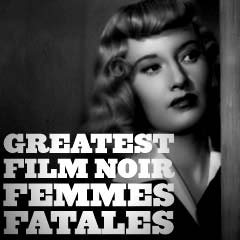
Greatest Femmes Fatales in Classic Film Noir: Classic film noir
developed during and after World War II, taking advantage of the
post-war ambience of anxiety, pessimism, and suspicion, and possibly
reflecting male fears of female liberation and independence during the
war years. Film noirs first
evolved in the 1940s, became prominent in the post-war era, and
lasted in
a classic "Golden Age" period until about 1960. A film noir
story was often developed around a cynical, hard-hearted,
disillusioned male character [e.g., Robert Mitchum, Fred MacMurray, or
Humphrey Bogart] who encountered a beautiful but promiscuous, amoral,
double-dealing and seductive femme fatale [e.g., Mary Astor, Veronica Lake, Jane Greer, Barbara Stanwyck, Joan Bennett or Lana Turner were the most prominent]. Femme fatale literally means "killer (or deadly) woman."
The character type of femme fatale was derived
from the anti-heroine vamps of early cinema, such as Theda Bara in A
Fool There Was (1915). She was first introduced as an evil temptress
with her character name of Vampire, and she spoke her most-famous
line of all: "Kiss me, my Fool!" The full-bosomed Bara,
dubbed the "Vamp,"
was the screen's first femme fatale, predatory vamp and first movie
sex goddess. She was a Hollywood creation who mixed ruthlessness and
dark erotic sexiness into her numerous roles. Flappers in the Roaring
Twenties, helped along with the popularity of "It" Girl Clara
Bow, and the German film Pandora's Box (1929) with Louise Brooks
as the iconographic and erotic femme fatale, also contributed to the
archetypal development of the character.
The females in film noir were either of two types (or archetypes) - dutiful, reliable, trustworthy and loving women; or femmes fatales
- mysterious, duplicitous, subversive, double-crossing, gorgeous,
unloving, predatory, tough-sweet, unreliable, irresponsible,
manipulative and desperate women. Usually, the male protagonist in
film noir wished to elude his mysterious past, and had to choose what
path to take (or have the fateful choice made for him).
Invariably, the choice would be an overly
ambitious one, to follow the dangerous but desirable wishes of these
dames. It would be to follow the goadings of the traitorous,
self-destructive femme fatale who would lead the struggling,
disillusioned, and doomed hero into committing murder or some other
crime of passion coupled with twisted love. When the major character
was a detective or private eye, he would become embroiled and trapped in
an increasingly-complex, convoluted case that would lead to
fatalistic, suffocating evidences of corruption, irresistible love and
death. The femme fatale, who had also transgressed societal
norms with her independent and smart, menacing actions, would bring
both of them to a downfall.
A few of the greatest film noirs ever made didn't have a specific or major femme fatale role, such as: Kiss of Death (1947), Cry of the City (1948), The Naked City (1948), Raw Deal (1948), They Live By Night (1949),  The Third Man (1949), D.O.A. (1950), In a Lonely Place (1950), Night and the City (1950), On Dangerous Ground (1951),
The Third Man (1949), D.O.A. (1950), In a Lonely Place (1950), Night and the City (1950), On Dangerous Ground (1951),  Touch of Evil (1958) and The Big Combo (1955). See genre description of film noir.
Touch of Evil (1958) and The Big Combo (1955). See genre description of film noir.
Note: The films that are marked with a yellow star are the films that Greatest Films has selected as the "100 Greatest Films".
are the films that Greatest Films has selected as the "100 Greatest Films".
Note: The films that are marked with a yellow star

Aucun commentaire :
Enregistrer un commentaire